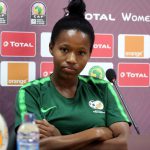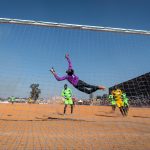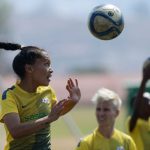A women’s league will not solve all Banyana’s problems
The national team’s shortcomings in international competition stem from more than having no domestic league, for which coach Desiree Ellis and the South African Football Association are pushing.
Author:
10 August 2019

The post-mortem of Banyana Banyana’s performance in the Fifa Women’s World Cup was predictable, borrowing a tired line that was used after their two Olympic appearances. Coach Desiree Ellis and the South Africa Football Association blamed the lack of a professional women’s league for Banyana crashing out in the group stage after scoring just one goal in France.
But there are other factors that are a stumbling block in their progression on the world stage. The lack of a professional women’s league allows these factors to be papered over, which means no honest assessment is made beyond the league. This World Cup was an opportunity for Banyana to showcase what they have learned from two Olympic appearances. But that wasn’t the case as they continued to struggle to get a positive result in the international arena.
Related article:
The South African national team left France still searching for their first win at a major international competition, having scored just two goals in those nine matches. Ideally, Banyana should be Africa’s leading women’s football team but they seem to still be a work in progress.
Although South Africa doesn’t have a professional women’s league, they are one of the few countries on the continent that has an organised competition for women. The Sasol League houses 144 teams that compete provincially in the hope of becoming the country’s best in the championships, which pit the nine provincial winners against each other. The University Sports South Africa play-offs also offer a number of female players the chance to play competitive football.
Compared with Africa
There are other competitions, like the MAP Games, Discovery Walter Sisulu Soccer Challenge and Zodwa Khoza Memorial Cup, in which players are tested against others in the country. Other African countries don’t get as much action during the year. Nigeria is among the exceptions, with a league and a cup competition, but they don’t have a sponsor.
Related article:
Despite the lack of financial strength, Nigeria’s Super Falcons have achieved more than Banyana on the continent and in the international arena. It’s not only their performance on the field that puts Nigeria ahead of South Africa but also their mental strength, which surpasses that of their Banyana counterparts, giving them an edge.
This was evident in the Women’s Africa Cup of Nations (Afcon). After losing to Banyana in the opening game of the tournament, the Super Falcons regrouped to march to the final and hold their nerve against Banyana in the penalty shoot-out.
Banyana’s technical team let the side down with their approach. The team, which usually attacks, played deep into their own half throughout the World Cup. They showed too much respect to their more accomplished opponents.
“I didn’t see the need to defend against Spain. That is the match we should have won, we created the most chances in that match but only to come out with one goal and a loss. Our group wasn’t that tough, we could have come out with four points. I mean, the team we beat at the AWC [Women’s Afcon] went through to the next round. We could have done it, too,” said Mamelodi Sundowns Ladies coach Jerry Tshabalala.
By playing deep in their own half, Banyana allowed the Spaniards to gain greater confidence and attack more often in the second half.
“I had to leave the VIP suite to go behind the bench and ask them why we were defending. We had to attack but we played defensively, inviting them into our half. I asked them, but no one answered me,” said Banyana legend and World Cup ambassador Portia Modise.
Surprising team selection
Playing defensive football was not the only questionable decision Ellis made at the tournament. After Nothando Vilakazi was suspended for the match against China, South Africa needed an experienced player to fill her shoes. Instead, former Under-17 captain Sibulele Holweni was thrown into the left back position that Vilakazi has occupied consistently since 2008. Ellis could have used a more experienced player such as Leandra Smeda, who has played in a defensive role for Banyana previously. Smeda has proven to be a versatile player.
“I was shocked to see a right-footed player in that position. But what shocked me more was that when Banyana played one of their preparation matches, she [Holweni] was played in an attacking position. Yet when the World Cup came, you play her at the back,” said Tshabalala.
Related article:
The biggest Achilles heel in Banyana’s World Cup campaign was the team selection. Teams like Nigeria and Cameroon were consistent in their line-ups. Nigeria made only four changes to the squad that won the Women’s Afcon in Ghana in December, while Banyana made seven. This included players who had one or no Banyana cap at all. Ellis struggled to find the balance of fielding a competitive team and giving young players the experience to carry on the job in the future.
Banyana were better prepared for the World Cup than Cameroon or Nigeria. They played nine matches that included facing World Cup finalists the US and Netherlands (whom they played twice), along with Sweden and Jamaica, and participating in this year’s Cyprus Cup, where they regressed from the sixth place they achieved last year to finish 10th. Ellis chopped and changed the team in those matches, ensuring that everyone was given a chance and she could find a solid team. But that chopping and changing stretched into the World Cup.
“When did Ode [Fulutudilu] get time to gel with the other players? And Kholosa [Biyana], where did she come from? When would have these players gotten time to adjust? Inconsistency in squad selection is one of the things that killed us. We would have progressed if we stuck to a particular team from the AWC,” said Tshabalala.
Bowing to supporter pressure
Fulutudilu and Biyana were not part of the team that helped Banyana qualify for their first World Cup. Biyana had been out with knee and ankle injuries in the run-up to Afcon, while Fulutudilu, a former Malaga FC player, had not been with the team since their friendly against Chile in October. Players like Jermaine Seoposenwe and Smeda, who were key in getting Banyana into the final of the Women’s Afcon, hardly played in the World Cup.
“I feel some of the players were called into the team because the coach felt the pressure of impressing people. It’s the same with [Thembinkosi] Lorch at Afcon. [Bafana Bafana coach] Stuart [Baxter] was pressured to play him because the nation called for him, he wasn’t in the coach’s plans. He didn’t fit the coach’s philosophy but he had to play him because fans at home were calling for him. I think coach Ellis bowed to the pressure and went with the players the public were calling for. As a coach, you have to be strong and know what you want,” said Tshabalala.
Now, post-World Cup, is the time for Banyana to reflect and chart a way forward to ensure they are competitive in the Olympics next year and give themselves a shot at being African champions for the first time. The proposed national women’s league will go a long way in strengthening women’s football in the country. But it won’t solve all the problems in women’s football in the country. An honest assessment is needed so that the team can grow and celebrate more than just qualification.



